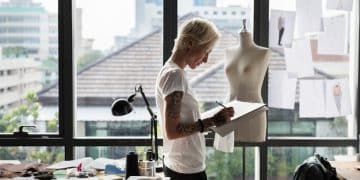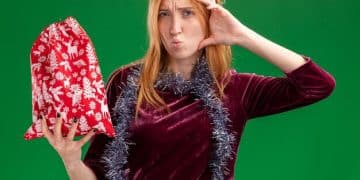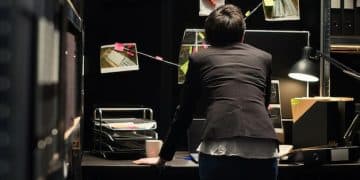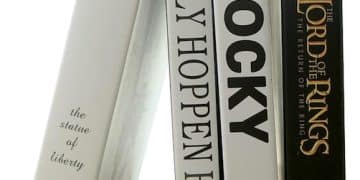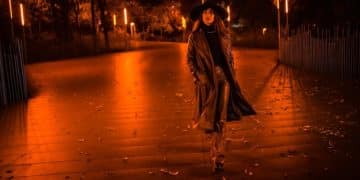Unsung Heroes: Celebrating the Costume Designers of Film
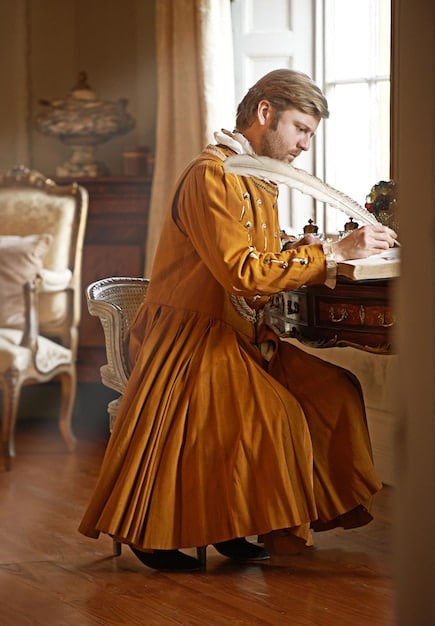
Anúncios
Costume designers are the unsung heroes of film, crafting visually stunning and narrative-enhancing wardrobes that define characters and transport audiences into the world of the story.
Anúncios
Step into the captivating world of cinematic storytelling and, beyond the enthralling narratives and charismatic performances, discover another layer of artistry: the world of costume design, where dedicated artists weave magic into every stitch and seam, bringing characters to life.
The Power of Costume Design
Costume design is more than just clothing; it’s a vital component of filmmaking. It establishes character, conveys social status, and contributes significantly to the overall visual storytelling.
Anúncios
From historical epics to futuristic adventures, the costumes reflect the time period, the characters’ personalities, and the emotional tone of the film, seamlessly guiding us through the narrative tapestry.
Defining Characters Through Wardrobe
A character’s clothing speaks volumes before they even utter a word. A meticulously crafted costume can reveal a character’s social standing, occupation, personality, and even their inner desires.
Consider the iconic status of specific costumes: the little black dress from *Breakfast at Tiffany’s* (1961), which conveyed elegance and sophistication, or the rugged attire of Indiana Jones, which spoke of adventure and resilience.
Historical Accuracy vs. Creative License
In historical films, costume designers face the challenge of balancing historical accuracy with the demands of storytelling. Rigorous research is often required to ensure authenticity.
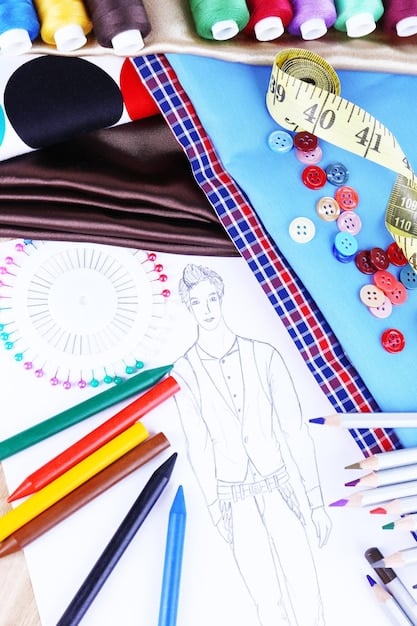
However, designers often exercise creative license to enhance the visual appeal and emotional impact of the costumes, ensuring they complement the narrative without compromising historical essence.
Costume design is crucial because it not only reflects the world of the narrative but also enhances the visual experience, providing key information about characters and their surroundings.
Notable Costume Designers in Film History
Throughout film history, certain costume designers have consistently demonstrated exceptional talent and vision, leaving an indelible mark on the industry.
These creative minds have not only crafted memorable wardrobes but also contributed to the overall success and enduring appeal of numerous films.
Edith Head: A Hollywood Legend
Edith Head remains one of the most celebrated costume designers in Hollywood history, with eight Academy Awards to her name. Her versatility and attention to detail were unparalleled.
Head worked on a wide array of films, from romantic comedies to suspenseful thrillers, always delivering costumes that perfectly captured the essence of each story.
Milena Canonero: A Master of Period Pieces
Milena Canonero has won four Academy Awards for her work on such visually stunning films as *Barry Lyndon* (1975) and *Marie Antoinette* (2006). She specializes in period pieces, meticulously recreating the fashion of bygone eras.
Canonero’s attention to historical accuracy and her ability to infuse her costumes with dramatic flair have made her one of the most respected designers in the industry.
Colleen Atwood: A Modern Visionary
With four Oscars to her name, Colleen Atwood is a contemporary costume designer known for her innovative and imaginative creations. She has collaborated with directors like Tim Burton and Rob Marshall, bringing their fantastical visions to life.
Atwood’s costumes are often elaborate and theatrical, reflecting the unique aesthetic of each film while also serving the needs of the characters and story.
- Edith Head
- Milena Canonero
- Colleen Atwood
These notable figures have defined and redefined the role of costume designers in film, paving the way for future generations of artists to express creativity and bring narratives to life.
The Collaborative Process: Designer and Director
The making of a film is fundamentally a collaborative process, and the relationship between the costume designer and the director is a particularly crucial partnership.
In this relationship, clear communication, shared vision, and mutual respect ensure that the costumes effectively serve the story.
Shared Vision and Communication
A successful collaboration begins with a clear understanding of the director’s vision for the film. The costume designer must grasp the story’s themes, the characters’ motivations, and the overall tone.
Open communication between the director and designer allows for a free exchange of ideas and ensures that the costumes align seamlessly with the director’s artistic goals.
Character Development and Costume Choices
The director often has specific ideas about how they envision each character and their evolution throughout the film. The costume designer then translates these ideas into tangible wardrobe choices.
Through discussions and sketches, the designer presents options that reflect the character’s personality, background, and emotional journey, ensuring that the costumes authentically represent the director’s vision.
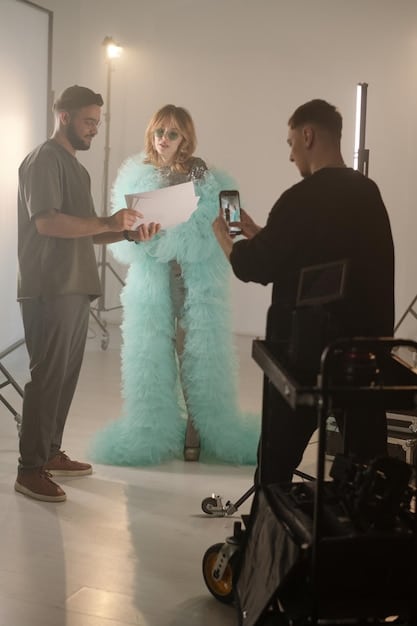
Trust and Creative Autonomy
While the director provides guidance and feedback, they must also trust the costume designer’s expertise and creative instincts.
Directors who allow designers creative autonomy often reap the benefits of innovative and imaginative costume designs that elevate the film’s visual storytelling in unexpected ways.
Ultimately, the collaborative process between the costume designer and the director is essential for creating a cohesive and visually compelling film, where the costumes contribute significantly to the narrative’s impact.
Challenges Faced by Costume Designers
Despite their significant contributions, costume designers often face numerous challenges in their profession, ranging from budgetary constraints to sourcing unique materials.
These challenges require creativity, resourcefulness, and unwavering dedication to their craft.
Budgetary Constraints and Resourcefulness
One of the most common challenges costume designers face is working within a limited budget. They must find creative ways to source materials, create costumes, and manage their teams efficiently.
Resourcefulness is key, as designers often need to repurpose existing garments, negotiate with suppliers, and find affordable alternatives without compromising the overall look and feel of the costumes.
Sourcing Unique and Period-Specific Materials
For period films or projects set in unique worlds, sourcing appropriate materials can be a significant challenge. Designers may need to scour vintage shops, antique markets, and specialty suppliers to find authentic fabrics and trims.
In some cases, they may even need to have materials custom-made to meet the specific requirements of the project, adding to the complexity and expense of the process.
Time Constraints and Production Deadlines
Film productions often operate on tight schedules, leaving costume designers with limited time to create and fit costumes for a large cast. This requires exceptional organizational skills and the ability to work under pressure.
- Budgetary Restrictions
- Time Constraints
- Material Sourcing Challenges
Overcoming these challenges requires a blend of creativity, problem-solving skills, and a deep understanding of the materials and techniques involved in costume design. Costume designers continue to bring their visions to life, enriching visual storytelling despite difficulties faced.
The Evolution of Costume Design Technology
Costume design, like all creative fields, has been significantly impacted by technological advancements. New tools are enhancing designers’ workflow and expanding their creative possibilities.
From digital design software to advanced fabrication techniques, technology is reshaping the landscape of costume design.
Digital Design and 3D Modeling
Digital design software allows designers to create detailed sketches, experiment with different color palettes, and visualize costumes in 3D before any fabric is cut. This technology streamlines the design process and reduces the risk of costly errors.
3D modeling also enables designers to create intricate patterns and embellishments that would be difficult or impossible to achieve using traditional methods.
Advanced Fabrication Techniques
Advanced fabrication techniques, such as laser cutting and 3D printing, allow designers to create complex shapes and textures with greater precision and efficiency. These technologies are particularly useful for creating futuristic or fantastical costumes.
Laser cutting can be used to create intricate patterns on fabric, while 3D printing can produce custom armor, jewelry, and other accessories.
Virtual Reality and Costume Visualization
Virtual reality (VR) technology is increasingly being used to visualize costumes in a virtual environment. This allows designers to see how the costumes will look on an actor in motion and to make adjustments before any physical costumes are created.
VR also provides a more immersive and interactive experience for directors and actors, allowing them to provide feedback and collaborate more effectively on costume choices.
These advancements in technology not only enhance accuracy and efficiency but also allow costume designers to explore uncharted creative territories.
Impact on Cultural and Fashion Trends
Costume design in film has a profound impact on cultural and fashion trends, often influencing the way people dress and express themselves.
Certain costumes have become iconic, inspiring fashion designers and setting trends that resonate far beyond the screen.
Iconic Costumes and Fashion Inspiration
Many iconic costumes from films have inspired fashion designers and influenced mainstream fashion trends. The flapper dresses from *The Great Gatsby* (2013) sparked a resurgence of 1920s-inspired fashion.
Similarly, the punk-inspired costumes in *Blade Runner* (1982) and *Mad Max* (1979) contributed to the rise of dystopian and post-apocalyptic fashion styles.
Influence on Street Style
Film costumes can also influence street style, as people emulate the looks of their favorite characters. The minimalist and futuristic costumes in *The Matrix* (1999) inspired a wave of all-black outfits, long coats, and sleek accessories.
The bohemian and free-spirited costumes in films like *Almost Famous* (2000) led to a revival of vintage clothing, flowing dresses, and eclectic accessories.
Setting Trends and Shaping Perceptions
Costume design not only reflects existing fashion trends but also sets new ones. By showcasing innovative and visually striking costumes, films can introduce new styles, colors, and silhouettes to the public.
- Cultural Reflection
- Trend Setting
- Iconic Imagery
Costumes in film play a pivotal role in setting the stage for fashion trends and influencing visual culture, highlighting the artistry and inventiveness of costume designers.
| Key Point | Brief Description |
|---|---|
| 🎬 Costume Design’s Role | Essential for defining characters and enhancing storytelling. |
| 🌟 Notable Designers | Edith Head, Milena Canonero, and Colleen Atwood. |
| 🤝 Collaboration | Crucial partnership between designer and director. |
| 👗 Cultural Impact | Influences fashion trends and street style. |
FAQ
A costume designer creates the outfits for characters in a film or stage production, ensuring each costume reflects the character’s personality and the story’s themes.
Costume designers dive into extensive research, consulting historical records, artwork, and fashion archives to accurately recreate clothing from specific eras.
Collaboration ensures that the costumes align with the director’s vision and character interpretations, creating a consistent and cohesive visual narrative.
Technology allows for digital design, 3D modeling, and advanced fabrication techniques, enhancing precision, efficiency, and creative possibilities in costume creation.
Iconic film costumes often inspire fashion designers and street style, setting trends and shaping perceptions of style and visual culture worldwide.
Conclusion
In conclusion, the role of costume designers in film is essential, enhancing storytelling and influencing cultural trends. Costume designers continue to transform the world of cinema with their creativity and artistry. Their skill and attention to detail bring narratives to life.

